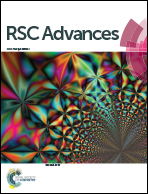Self-assembly characteristics of a structural analogue of Tjernberg peptide†
Abstract
Molecular self-assembly of peptides have gained attention in the recent years due to the reproducibility of nanostructures that are formed with a high degree of control over the kinetics of formation. These self-assembled nanostructures have been widely exploited for drug delivery, tissue engineering and also serve as model systems to understand the pathogenesis behind protein misfolding diseases. In our study, an attempt has been made to understand the pathogenesis behind the formation of amyloid plaques using a modified version of the KLVFF peptide. The self-assembly of the RIVFF peptide was investigated in various substrates and at different pH. Our data revealed that the novel pentapeptide RIVFF self assembles into micelles of about 10 nm, which was confirmed by electron microscopy. The presence of hydrogen bonded beta sheet structures in the micelles was confirmed using FTIR, SAED, CD and thioflavin binding assay. The formation of higher order structures by the peptide at various pH and substrates was investigated using SEM. Finally the mode of action of the micelles formed by the peptide was confirmed by cytotoxicity studies in IMR-32 human neuroblastoma cell lines. The cytotoxicity of the nanostructures formed by the peptide may be attributed to the amino acids with long side chains along with hydrophobic amino acids resembling the cytotoxicity of amyloid beta peptide.


 Please wait while we load your content...
Please wait while we load your content...